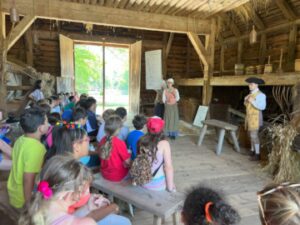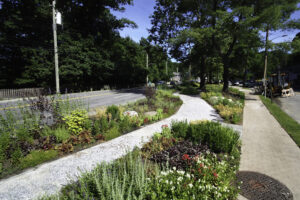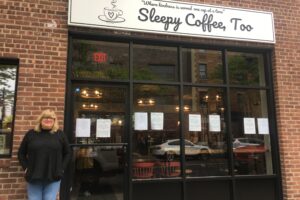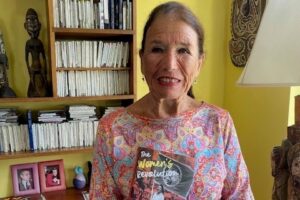
Washington Irving fourth-graders crossed the bridge back in time to the Colonial North, visiting Philipsburg Manor in June. Just up the road from the school, students learned about the slave community’s life and work on the Homestead, including farming, milling, and the Philipse family’s trading of local goods to the West Indies.
Docents shared that an inventory document for the estate, listing the 23 Africans as property, sheds light on enslaved people’s lives, from their names and ages to suggestions of the jobs they did. By touring buildings and listening to the docent’s stories, the students discovered what the enslaved person’s day-to-day lives were like working the land and caring for themselves and each other.
“Wow, it smells like lemon,” Charlotte chimed after learning that herbs like lemon balm were grown in dedicated gardens as the resident’s medicines. Students toured the Manor House, with its two distinctly different floors, for Mr. Philipse upstairs and the slave women on the ground floor. Enslaved women Abigail, Dina, and Sue worked the dairy on the ground floor and slept in the attached kitchen. Students took turns trying the empty churning bucket while the docents explained that their work was grueling, churning butter after milking the cows and lugging heavy milk buckets on yokes daily.
“It seemed that they worked so hard, all for someone else,” said one of Ms. Devivo’s insightful Fourth graders. Walking in the footsteps of the enslaved Africans through the buildings where they spent their lives working impacted the young students.
Flour and grain were the biggest exports from the Philipse Estate. Slaves Tom and Caesar ran the Grist Mill, powered by water from the Pocantico River, turning out 30,000 pounds of flour each week. Labor in the Grist Mill was taxing and backbreaking, grinding the wheat coarser and finer for export with the salt-preserved butter. Leaving from the Philipse Manor dock, bound first for Manhattan before the West Indies, merchants traded the commercial products for unique items like cocoa and goods like fabric and pottery.
Students were fascinated by the lessons about how Dutch, African, and Native American cultures melded together, the history of slavery in Sleepy Hollow, and how the enslaved people owned by the Philipse’s lived on the colonial-era estate. The field trip aligned with the Fourth grade social studies curriculum studying Native Americans to the new nation with an emphasis on New York State specifically during these times.
“It’s amazing the great history we have here in our own community,” said Ms. Devivo. “Many students were excited to go and explore a landmark that they pass everyday and learn about the people who once lived there.”







